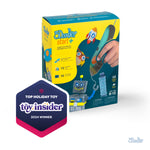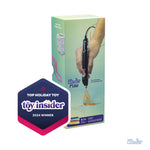Alpha-Doodles
In this phonics activity, students will work in pairs to practice arranging letters to form words in the -at word family and sound them out. Students will first doodle alphabet letters to look like an object or animal that begins with that letter. Using this association to recall letter sounds, students will read each word they make. *This activity can be repeated with any word family, e.g., -ig, -it, op, etc. *For older students add initial consonant blends, e.g., brat, flat, gnat, etc.

KnowledgeStudents havepracticed single letter sounds of alphabet letters.
practiced the short “a” sound.
practiced sounding out short words.
practiced using a 3Doodler to outline and fill in shapes.
practiced single letter sounds of alphabet letters.
practiced the short “a” sound.
practiced sounding out short words.
practiced using a 3Doodler to outline and fill in shapes.
ObjectivesStudents willuse tools, i.e., 3Doodler to fill in 3Doodler alphabet stencils.
arrange letters to create -at family words.
recognize each letter-sound.
blend each letter-sound to read a word.
use tools, i.e., 3Doodler to fill in 3Doodler alphabet stencils.
arrange letters to create -at family words.
recognize each letter-sound.
blend each letter-sound to read a word.
MaterialsStudents will need3Doodler (1 per pair)
Alpha Doodles Worksheet (1 per pair)
pencil (2 per pair)
3Doodler (1 per pair)
Alpha Doodles Worksheet (1 per pair)
pencil (2 per pair)
Lesson PlanInstructions
Step 1 - PREPARATION● Review words in the Alpha Doodles Worksheet with students: at, bat, cat, fat, hat, mat, pat, rat and sat.
● Give students sufficient time to practice using the 3Doodler, e.g., outlining, filling in an area.
● Doodle the letters on the Alpha Doodles Worksheet worksheet as an example. Leave the letter “a” to complete with students during the lesson.
Step 2Whole group: Project your tablet or computer screen on the board. Review the sounds of each of the following letters with your students: a, b, c, f, h, m, p, r, s, t.
Step 3Ask students to think of an object or animal that begins with each letter. Chart their responses for students to view. Examples: a-alligator, b-banana, c-cracker...
Step 4Think out loud: Note that the word “apple” begins with the letter “a” and how it is similarly round like an apple. On a whiteboard, write the letter “a” and add a stem and a leaf, so it looks similar to the doodled alphabet “a” in the Alpha Doodles Worksheet. Do the same for each letter on the worksheet, sharing the animal/object and initial letter-sound.
Step 5Share the goal: Today, students will doodle letters to create words in the -at family. Note that all “at” words have the short “a” sound in them. Exaggerate this sound as you say it.
Step 6Using the Alpha Doodles Worksheet, demonstrate how to use the 3Doodler to trace each Alpha-Doodle. Note that the doodles will help us remember the sound each letter makes. Example: The letter “b” makes the “buh, buh sounds as in bumblebee.” Chant this together.
Step 7Peel off your doodled “a” and pass it around, so students can feel its curved shape. Note how it is round like an apple. Have students chant, “Ah ah- apple” as they touch the doodled “a.” Repeat with each letter on the Alpha-Doodle worksheet.
Step 8Divide students into pairs. *Doodling the letters will probably take more than one session.
Step 9Hand out 3Doodlers and Alpha Doodles Worksheet.
Step 10Circle to assist and assess. *It is good to have someone assist you, like a parent or aid.
● Review words in the Alpha Doodles Worksheet with students: at, bat, cat, fat, hat, mat, pat, rat and sat.
● Give students sufficient time to practice using the 3Doodler, e.g., outlining, filling in an area.
● Doodle the letters on the Alpha Doodles Worksheet worksheet as an example. Leave the letter “a” to complete with students during the lesson.
Whole group: Project your tablet or computer screen on the board. Review the sounds of each of the following letters with your students: a, b, c, f, h, m, p, r, s, t.
Ask students to think of an object or animal that begins with each letter. Chart their responses for students to view. Examples: a-alligator, b-banana, c-cracker...
Think out loud: Note that the word “apple” begins with the letter “a” and how it is similarly round like an apple. On a whiteboard, write the letter “a” and add a stem and a leaf, so it looks similar to the doodled alphabet “a” in the Alpha Doodles Worksheet. Do the same for each letter on the worksheet, sharing the animal/object and initial letter-sound.
Share the goal: Today, students will doodle letters to create words in the -at family. Note that all “at” words have the short “a” sound in them. Exaggerate this sound as you say it.
Using the Alpha Doodles Worksheet, demonstrate how to use the 3Doodler to trace each Alpha-Doodle. Note that the doodles will help us remember the sound each letter makes. Example: The letter “b” makes the “buh, buh sounds as in bumblebee.” Chant this together.
Peel off your doodled “a” and pass it around, so students can feel its curved shape. Note how it is round like an apple. Have students chant, “Ah ah- apple” as they touch the doodled “a.” Repeat with each letter on the Alpha-Doodle worksheet.
Divide students into pairs. *Doodling the letters will probably take more than one session.
Hand out 3Doodlers and Alpha Doodles Worksheet.
Circle to assist and assess. *It is good to have someone assist you, like a parent or aid.
Wrap Up
Assessment
Possible Extensions
Resources
Vocabulary
alphabet - set of letters or other characters with which one or more languages are written especially if arranged in a customary order.
drawing - the art or technique of representing an object or outlining a figure, plan, or sketch by means of lines.
language arts - the subjects (such as reading, spelling, literature, and composition) that aim at developing the student's comprehension and capacity for use of written and oral language.
literacy - the quality or state of being literate.
phonics - a method of teaching beginners to read and pronounce words by learning the phonetic value of letters, letter groups, and especially syllables.
reading - the form or version of a given passage in a particular text.
sight words - commonly used words that young children are encouraged to memorize as a whole by sight, so that they can automatically recognize these words in print without having to use any strategies to decode.
word family - commonly used words that young children are encouraged to memorize as a whole by sight, so that they can automatically recognize these words in print without having to use any strategies to decode.
Educational Standards
Recognize that spoken words are represented in written language by specific sequences of letters.
Students will sound out each letter in the -at family.
Isolate and pronounce the initial, medial vowel, and final sounds (phonemes) in three-phoneme (consonant-vowel-consonant, or CVC) words. (This does not include CVCs ending with /l/, /r/, or /x/.)
Students will recognize the initial, short -a and final sound in each word from the -at family.
Know and apply grade-level phonics and word analysis skills in decoding words.
Students will apply grade-level phonics to sound out each word in the -at family.
Demonstrate basic knowledge of one-to-one letter-sound correspondences by producing the primary sound or many of the most frequent sounds for each consonant.
Students will demonstrate basic knowledge of one-to-one letter-sound correspondences by producing the primary sound or many of the most frequent sounds for each consonant in the -at family.
Decompose (break down) a larger problem into smaller sub-problems with teacher guidance or independently.
Students will break down the process of sounding out words in the -at family, doodling them, touching them, practicing their sounds, arranging them as words, and sounding them out.
Use technology to seek feedback that informs and improves their practice and to demonstrate their learning in a variety of ways.
Students will use the 3Doodler to create doodled alphabet letters.
Create original works or responsibly repurpose or remix digital resources into new creations.
Students will use a 3Doodler to doodle alphabet letters and design their own in the extension activity.
Use collaborative technologies to work with others, including peers, experts or community members, to examine issues and problems from multiple viewpoints.
Students will seek feedback from a partner during all stages of the process for this activity and the extension activity.





